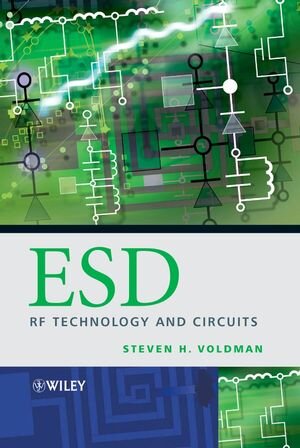With the growth of high-speed telecommunications and wirelesstechnology, it is becoming increasingly important for engineers tounderstand radio frequency (RF) applications and their sensitivityto electrostatic discharge (ESD) phenomena. This enables thedevelopment of ESD design methods for RF technology, leadingto increased protection against electrical overstress (EOS) andESD.
ESD: RF Technology and Circuits:
* Presents methods for co-synthesizisng ESD networks for RFapplications to achieve improved performance and ESD protection ofsemiconductor chips;
* discusses RF ESD design methods of capacitance loadtransformation, matching network co-synthesis, capacitance shunts, inductive shunts, impedance isolation, load cancellation methods, distributed loads, emitter degeneration, buffering andballasting;
* examines ESD protection and design of active and passiveelements in RF complementary metal-oxide-semiconductor (CMOS), RFlaterally-diffused metal oxide semiconductor (LDMOS), RF BiCMOSSilicon Germanium (SiGe), RF BiCMOS Silicon Germanium Carbon(SiGeC), and Gallim Arsenide technology;
* gives information on RF ESD testing methodologies, RFdegradation effects, and failure mechanisms for devices, circuitsand systems;
* highlights RF ESD mixed-signal design integration of digital, analog and RF circuitry;
* sets out examples of RF ESD design computer aided designmethodologies;
* covers state-of-the-art RF ESD input circuits, as well asvoltage-triggered to RC-triggered ESD power clamps networks in RFtechnologies, as well as off-chip protection concepts.
Following the authors series of books on ESD, this book will bea thorough overview of ESD in RF technology for RF semiconductorchip and ESD engineers. Device and circuit engineers working in theRF domain, and quality, reliability and failure analysis engineerswill also find it a valuable reference in the rapidly growing areof RF ESD design. In addition, it will appeal to graduate studentsin RF microwave technology and RF circuit design.
ESD: RF Technology and Circuits:
* Presents methods for co-synthesizisng ESD networks for RFapplications to achieve improved performance and ESD protection ofsemiconductor chips;
* discusses RF ESD design methods of capacitance loadtransformation, matching network co-synthesis, capacitance shunts, inductive shunts, impedance isolation, load cancellation methods, distributed loads, emitter degeneration, buffering andballasting;
* examines ESD protection and design of active and passiveelements in RF complementary metal-oxide-semiconductor (CMOS), RFlaterally-diffused metal oxide semiconductor (LDMOS), RF BiCMOSSilicon Germanium (SiGe), RF BiCMOS Silicon Germanium Carbon(SiGeC), and Gallim Arsenide technology;
* gives information on RF ESD testing methodologies, RFdegradation effects, and failure mechanisms for devices, circuitsand systems;
* highlights RF ESD mixed-signal design integration of digital, analog and RF circuitry;
* sets out examples of RF ESD design computer aided designmethodologies;
* covers state-of-the-art RF ESD input circuits, as well asvoltage-triggered to RC-triggered ESD power clamps networks in RFtechnologies, as well as off-chip protection concepts.
Following the authors series of books on ESD, this book will bea thorough overview of ESD in RF technology for RF semiconductorchip and ESD engineers. Device and circuit engineers working in theRF domain, and quality, reliability and failure analysis engineerswill also find it a valuable reference in the rapidly growing areof RF ESD design. In addition, it will appeal to graduate studentsin RF microwave technology and RF circuit design.







